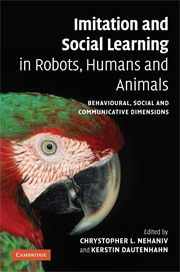 Imitation and Social Learning in Robots, Humans and Animals
Imitation and Social Learning in Robots, Humans and Animals Book contents
- Frontmatter
- Contents
- List of plates
- List of figures
- List of tables
- List of contributors
- Introduction: the constructive interdisciplinary viewpoint for understanding mechanisms and models of imitation and social learning
- Part I Correspondence problems and mechanisms
- Part II Mirroring and ‘mind-reading’
- 4 A neural architecture for imitation and intentional relations
- 5 Simulation theory of understanding others: a robotics perspective
- 6 Mirrors and matchings: imitation from the perspective of mirror-self-recognition, and the parietal region's involvement in both
- Part III What to imitate?
- Part IV Development and embodiment
- Part V Synchrony and turn-taking as communicative mechanisms
- Part VI Why imitate? – Motivations
- Part VII Social feedback
- Part VIII The ecological context
- Index
- Plate section
- References
5 - Simulation theory of understanding others: a robotics perspective
Published online by Cambridge University Press: 10 December 2009
- Frontmatter
- Contents
- List of plates
- List of figures
- List of tables
- List of contributors
- Introduction: the constructive interdisciplinary viewpoint for understanding mechanisms and models of imitation and social learning
- Part I Correspondence problems and mechanisms
- Part II Mirroring and ‘mind-reading’
- 4 A neural architecture for imitation and intentional relations
- 5 Simulation theory of understanding others: a robotics perspective
- 6 Mirrors and matchings: imitation from the perspective of mirror-self-recognition, and the parietal region's involvement in both
- Part III What to imitate?
- Part IV Development and embodiment
- Part V Synchrony and turn-taking as communicative mechanisms
- Part VI Why imitate? – Motivations
- Part VII Social feedback
- Part VIII The ecological context
- Index
- Plate section
- References
Summary
Introduction
Simulation theory
According to the simulation theory, ‘human beings are able to use the resources of their own minds to simulate the psychological etiology of the behaviour of others’, typically by making decisions within a ‘pretend context’ (Gordon, 1999). During observation of another agent's behaviour, the execution apparatus of the observer is taken ‘off-line’ and is used as a manipulable model of the observed behaviour.
From a roboticist's point of view, the fundamental characteristics of the simulation theory are:
Utilization of the same computational systems for a dual purpose; both behaviour generation as well as recognition.
Taking systems off-line (suspending their normal input/output) which necessitates a redirection and suppression of input (feeding ‘pretend states’ following a perspective taking process, suppressing the current ones that are coming from the visual sensors while this is performed) and output from/to the system to achieve this dual use.
Simulation theory is often set as a rival to the ‘theory-theory’, where a separate theoretical reasoning system is used; the observer perceives and reasons about the observed behaviour not by simulating it, but by utilizing a set of causal laws about behaviours.
It is important to note that in the experiments we describe here, ‘understanding’ the demonstrated behaviour equates to inferring its goal in terms of sensorimotor states, and does not imply inference of the emotional, motivational and intentional components of mental states.
Information
- Type
- Chapter
- Information
- Imitation and Social Learning in Robots, Humans and AnimalsBehavioural, Social and Communicative Dimensions, pp. 89 - 102Publisher: Cambridge University PressPrint publication year: 2007
References
Accessibility standard: Unknown
Why this information is here
This section outlines the accessibility features of this content - including support for screen readers, full keyboard navigation and high-contrast display options. This may not be relevant for you.Accessibility Information
- 2
- Cited by